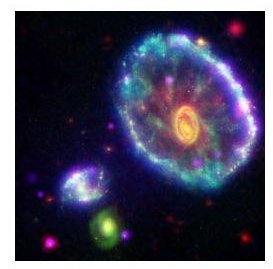Galactic Collisions and the Cartwheel Galaxy
Fritz Zwicky and the Cartwheel Galaxy
In 1941, the astronomer Fritz Zwicky discovered one of the more interesting celestial objects in the Cartwheel galaxy; its unique shape earned it its name. The galaxy belongs to a group of galaxies that make up the Sculptor constellation. It is approximately five hundred million light-years away and about one hundred fifty thousand light years across.
What is interesting about the galaxy is that it is believed to have formally been a spiral galaxy, similar to our galaxy the Milky Way. As galaxies are the largest structures that we classify in the universe itself, it is difficult to imagine something so large going through such a dramatic change. Of course, the only thing that could accomplish the restructuring of an entire galaxy is the collision with another galaxy.
The Cartwheel Galaxy
When Galaxies Collide
A well established aspect of the universe is that it’s expanding. In its expansion, solar systems and entire galaxies are in constant notion. It is through this function and gravity that collisions of the galactic magnitude happen. When two galaxies collide, planets, suns, and other celestial objects get thrown out of their orbits as the two massive forces of gravity collide and interact. The end result is an entirely new galaxy constituted of the remnants of the two galaxies involved in the collision.
It should be noted that these are not collisions in the traditional sense of two objects and their impacts upon each other. While galactic collisions is a more interesting term, evoking massive destruction, gravitational interaction is a more accurate term as the two galaxies never literally come into physical contact. The end result of the two galaxies merging also depends upon the relative size of the galaxies to each other. The probable intruding galaxy has found itself two hundred fifty thousand light-years away, giving us a way to approximate when this collision took place.
The Creation of New Stars
While planets and stars might not have literally collided in the Cartwheel galaxy, this does not mean that powerful forces were not unleashed. As the galaxies interacted, energy was released which blew gas and dust out from its center at colossal speeds. The blueish ring that can be seen at its center are clusters of new-born stars that resulted from this release of energy. There is a high concentration of supernovae in this center ring that are perpetually exploding.
These new stars add to the unique look of the galaxy, but this will not always be the case. As the gravitational disruption finally begins to level out, the new stars will take their place in the galaxy as it begins to re-take its original shape. As can be seen from photographs, the Cartwheel galaxy is already beginning to re-take the shape of a spiral galaxy at which point its name will be a misnomer. This process will take billions of years to complete. But for the time being it’s accurate to call this most intriguing celestial object the Cartwheel galaxy.
Credit and Sources
Picture: NASA/JPL-Caltech
